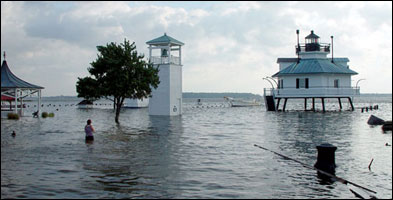and the Bay
Contents
Model Forecasts for a Warming Watershed
New Perspectives on the Chesapeake

No doubt about it. The earth is warming. Projections for future climate change predict a global increase of 2 to 10°F by the end of the century. And there is no question that human activities — the burning of fossil fuels and the dismantling of the world's great forests — have woven a blanket of greenhouse gases, mainly carbon dioxide, which now insulates the Earth from above.
Globally, we have begun to see the effects of warming temperatures. We've all heard the statistics. Five of the hottest years in recorded history have occurred in the past decade. Glaciers and ice sheets are melting. Sea level is rising.
Global warming has also begun to seep into the public consciousness — even as it remains politically contentious. People are talking about it. Journalists are writing about it. Movies like The Day After Tomorrow and An Inconvenient Truth have brought strong messages to a broad public.
David Kimmel, a scientist at the University of Maryland Center for Environmental Science's Horn Point Laboratory, recently asked his hair stylist if she believes in global warming. She responded that only six months ago, she probably would have said, "I don't know," but now she answered, "You know, I think that something is going on."
Still, recognizing the immediate impact of global warming in our daily lives and in our local environment remains a challenge. And doing something about it could prove an even greater one.
This issue of Chesapeake Quarterly follows the imprint of climate warming on the Chesapeake watershed — on the Bay's plants and animals, on its coastlines, and on the storms that could threaten its coastal communities. We meet scientists like Kimmel, who studies the impact of climate on the Bay's food web, and others who discuss how the warming climate may already be changing the Bay — affecting resources like blue crabs and underwater grasses — as well as other ecosystems around the world. They also offer us some predictions for what we might expect to see in the future.
The Chesapeake watershed already faces more than its share of problems. The long-term effects of nitrogen and phosphorus pollution have wrought fundamental changes in the ecosystem. Algae now dominate waters that were once clear and lush with underwater grasses. The empire of the native oyster is a long distant memory. More than 25 years of effort directed towards restoring the Bay has failed to bring it back.
Now global climate change could further slow restoration, hard news to swallow for a region where the political will to save the Bay has already been put to the test. Will we have what it takes to face up to this next challenge?
Scientists and managers in the region realize that we can't afford not to. They recognize that if we don't think about climate warming as we plan future restoration efforts for the Bay, we could end up spinning our wheels and squandering our dollars. But understanding the effect of climate change in this estuary is no small feat. Dramatic year-to-year variation in rainfall and temperature mask many telltale signatures. We have to start by learning to separate the signal from the noise.
As individuals, it is easy to feel paralyzed by the sheer magnitude of global warming. Over a pizza lunch one day in early October, just days after California governor Arnold Schwarzenegger signed that state's landmark Global Warming Solutions Act of 2006, the staff at Maryland Sea Grant sat down in the conference room to discuss how our office might reduce the size of our emissions footprint. We talked about our commutes, car gas mileage, office lighting, and computer energy savings — offering ideas about how to trim our consumption.
Lunchtime rhetoric over shared pizza seems a very small drop in a very large bucket, but the effort we dubbed "fighting carbon dioxide with carbs" felt like a step in the right direction. We all have to start somewhere, don't we?
![[Maryland Sea Grant]](/GIFs/h_footer_mdsg.gif)